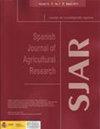Development of a laboratory setup simulating cabbage harvesting mechanism and optimization of torque requirement for harvesting cabbage
IF 0.8
4区 农林科学
Q3 AGRICULTURE, MULTIDISCIPLINARY
引用次数: 2
Abstract
Aim of study: To develop a new type of cabbage (Brassica oleracea L.) harvesting mechanism in the laboratory that can be used in small-scale cabbage harvester in Indian conditions with minimum power requirement. Area of study: Indian Institute of Technology, Kharagpur, India Material and methods: The mechanism consisted of a cutting unit, a pushing unit and a conveying unit. Two counter-rotating disc cutters were used as cutting devices. Cutting speed, forward speed and cutting position were considered as influential parameters for torque required to carry out the harvesting of cabbage. A full factorial design was followed for the experiment and response surface methodology was used to optimize these parameters for minimizing torque requirement for cutting and pushing the cabbage. Main results Torque decreased when cutting speed increased and when cutting height from the cabbage head decreased. Statistical analysis showed that cutting speed and cutting position affected the total torque significantly. The optimized cutting speed, forward speed and cutting position were found as 590 rpm, 0.25 m s-1 and 0 cm, respectively with a desirability of 0.995. A regression model was developed to predict the total torque for cutting the cabbage stem and it was validated against 10 datasets with a percentage of bias within 10%. Research highlights: The mechanism developed for cabbage harvesting could successfully cut and lift the cabbage heads in the laboratory. These optimized parameters are to be followed in the field prototype cabbage harvester for its successful operation in the field.白菜收获机理模拟实验装置的研制及收获所需扭矩的优化
研究目的:在实验室中开发一种新型的甘蓝(Brassica oleracea L.)收获机构,该机构可以在印度条件下以最小的功率需求用于小型甘蓝收获机上。研究领域:印度理工学院,Kharagpur,印度材料和方法:该机构由一个切割单元,一个推动单元和一个输送单元组成。采用两台反向旋转圆盘刀作为切割装置。考虑了切割速度、前进速度和切割位置是影响白菜收获所需扭矩的参数。试验采用全因子设计,利用响应面法对各参数进行优化,以最大限度地降低切推白菜所需的扭矩。主要结果:随着切割速度的增加和距离白菜头高度的降低,扭矩减小。统计分析表明,切削速度和切削位置对总转矩有显著影响。最佳切削速度为590 rpm,前进速度为0.25 m s-1,切削位置为0 cm,理想度为0.995。建立了一个回归模型来预测切白菜茎的总扭矩,并对10个数据集进行了验证,偏差百分比在10%以内。研究重点:所开发的白菜收获机制在实验室成功实现了白菜头的切提。这些优化后的参数将在田间样机白菜收获机中得到应用,使其在田间成功运行。
本文章由计算机程序翻译,如有差异,请以英文原文为准。
求助全文
约1分钟内获得全文
求助全文
来源期刊

Spanish Journal of Agricultural Research
农林科学-农业综合
CiteScore
2.00
自引率
0.00%
发文量
60
审稿时长
6 months
期刊介绍:
The Spanish Journal of Agricultural Research (SJAR) is a quarterly international journal that accepts research articles, reviews and short communications of content related to agriculture. Research articles and short communications must report original work not previously published in any language and not under consideration for publication elsewhere.
The main aim of SJAR is to publish papers that report research findings on the following topics: agricultural economics; agricultural engineering; agricultural environment and ecology; animal breeding, genetics and reproduction; animal health and welfare; animal production; plant breeding, genetics and genetic resources; plant physiology; plant production (field and horticultural crops); plant protection; soil science; and water management.
 求助内容:
求助内容: 应助结果提醒方式:
应助结果提醒方式:


